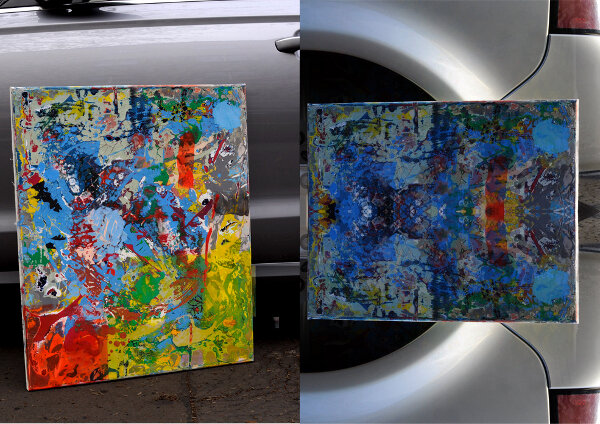WZUFALL UND WIEDERHOLUNG | NOTHING IN NOTHING IT IN
14 - 23 April 2017
Alexander Höpfner
WZUFALL UND WIEDERHOLUNG | NOTHING IN NOTHING IT IN
14 - 23 April 2017
CURATED BY X
So, what is it that Alexander Hoepfner does?
I had a chance to look at his work and to talk with him in his studio – about his views on his method and the artistic process, about his goals and visions.
After contemplating this for a while, I came to the conclusion that the best way to describe his method is: Alexander Hoepfner makes pictures.
„Oh, really“, I can hear you whisper, „That's what he does? It would never have occured to me.“
But wait: This realisation is not quite as trivial as it may sound. In fact, it is even exceptionally demanding.
It would be trivial only if it was known to anyone what a picture is in the first place. But the whole crew of phenomenological thinkers of the post-structuralist school have been struggling to find an answer to this question for years now – to no avail.
And why?
Because of their theoretical background. A picture, however – that much seems to be clear to me – is not a concept, but a practice.
And what kind of practice? Well, obviously: a practice of looking for pictures!
In my view, the renowned Picasso quote „I don't look, I find“ is actually a euphemism.
For what else is a finding than the execution of the search?
This is the only reason why we can find something we have not even been looking for.
In his Critique of Aesthetic Judgment, Immanuel Kant gives the example of an alchemist who tries to find the philosopher's stone and discovers phosphor instead (plus its chemical properties).
Without looking for something, one cannot find it. Finding means searching.
Now, what does all of this have to do with Alexander Hoepfner's pictures? It is my impression that he is the paradigmatic searcher. Searching means in his case: He is working off his findings.
He finds a motive, examines it in close-up, takes a picture of it. He then prints out the picture, blows it up and hangs it on the kitchen wall. He makes a drawing that focusses on individual details of the photo, and then develops it further.
It can be a watch inside a car: a meditation about time and space, speed and technology.
Or a zipper that is turned into garden fences, church towers, fishnet stockings: here he contemplates the concepts of opening and closing, interlocking and holding, but also of symmetry and complementation. It is a playful study of positive and negative shapes, figure and ground.
Alexander Hoepfner is aware that a motive is not a picture. A picture is a practice.
That's why he sends his pictures through various media. Just as you move mouthwash from one cheek to the other, then gargle it inside your throat before finally spitting it out.
The water in this metaphor is the motive, the different areas in your mouth and throat are the different media. Afterwards the motive is practically gone. But the picture, as the result of the practice, remains.
To stay with the analogy, the picture is a kind of hygiene: something that only exists while you are practicing it.
But doesn't that mean that it's impossible to separate the pictures from Alexander Hoepfner? Aren't they only an expression of his subjective feelings and sensations? Can you carry them away without leaving their meaning with the artist?
I am convinced that you can. For this seems to be the difference between the search for a picture and an actual picture: It „jumps over“, so to say. Because it is a practice, it is sort of contageous.
But I definitely want to leave the mouth water analogy behind now. Instead I would like to refer to the great phenomenologist Maurice Merleau-Ponty, who in his essay „Cézanne's Doubt“ (1942) wrote: „The painter can do no more than construct an image; he must wait for this image to come to life for other people. When it does, the work of art will have united these separate lives (...)“
This kind of „jumping over“, of infection is best achieved in a confined space – one of the many reasons why I think the „Saloon“ is the perfect location for an exhibition of this kind. Here the separation between humans can be just as easily overcome as the division between private and public, art and life.
I strongly recommend taking in Alexander Hoepfner's pictures as a practice. In other words: to look at them is an invitation to gargle on!
Allow yourself to become infected – and don't be afraid of GlaxoSmithKline. I don't think they will be around tonight.
Have fun, and thank you for your attention.
(Excerpt from a speech by Friedrich Weltzien at Alexander Hoepfner's exhibition „Splits – 1 Zimmer von Schwarzfahrer Kind Rot“, Saloon, Berlin.)
Prof. Dr. Friedrich Weltzien teaches creativity and perceptual psychology at the Hochschule Hannover, faculty III, department of design and media.


